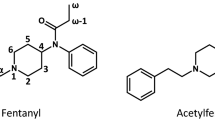Summary
Aldehyde dehydrogenase (ALDH) is involved in the metabolism of endogenous and exogenous, aldehydes originating from biogenic amines, lipids, food and drugs. Rat liver contains at least two cytosolic ALDHs that can be stimulated by inducers of drug metabolism. Phenobarbital-type inducers increase ALDH1 activity while polycyclic aromatic hydrocarbons (such as benzo[α]pyrene) an 2,3,7,8-tetrachlorodibenzo-p-dioxin (TCDD) increase ALDH3c isoenzyme activity. Two rat substrains were isolated according to a different induction of hepatic ALDH after treatment with phenobarbital (PB). Animals that responded to treatment (RR) and those that did not respond (rr) were inbred and divided into two homogenous groups. These animals constituted an ideal experimental model due to their common origin. Apart from the dramatic induction of cytosolic ALDH1 and ALDH3c, the effects of PB on pentoxy-, ethoxy-and methoxy-resorufin-O-dealkylase (P-, E-, and MROD) between the two substrains were also studied. 3-Methylcholanthrene (3MC) greatly increased ALDH3c levels in both substrains, although it was slightly more pronounced in the rr rats, in which it was assessed either as ALDH3c or as total cytosolic ALDH. A similar trend was also noted in EROD, PROD and MROD activities. Dealkylation of the methoxy group was found to be statistically different between the two substrains (rr>RR). The relevance of the biochemical findings with the in vivo hepatic capacity for drug metabolism was investigated by measuring the duration of zoxazolamine paralysis. Both animal substrains were tested with zoxazolamine either without pretreatment or after administration of PB or 3MC: the paralysis produced by zoxazolamine lasted for a longer period in rr than in RR rats. After pretreatment with PB, the duration of paralysis was greatly reduced, but the differences between the two substrains remained. Pretreatment with various doses of 3MC produced differences in the duration of paralysis in RR and rr rats, although the time period was much shorter than that observed in control animals.
Similar content being viewed by others
References
Esterbauer H. (1982): Aldehydic products of lipid peroxidation. In: McBrien D.C.H. and Slater T.F. (Eds.). Free Radicals, Lipid Peroxidation and Cancer. 101–128. Academic Press, N.Y.
Esterbauer H., Zollner H., Schaur R.J. (1990): Aldehydes formed by lipid peroxidation: mechanisms of formation, occurrence and determination. In: Vigo Pelfrey C. (Ed.). Membrane Lipid Oxidation. Florida, CRC Press, vol 1.
Marselos M., Lindahl R. (1988): Substrate preference of a cytosolic aldehyde dehydrogenase inducible in rat liver by treatment with 3-methylcholanthrene. Toxicol Appl. Pharmacol., 95, 339–345.
Lindahl R. (1992): Aldehyde dehydrogenases and their role in carcinogenesis. Cr. Rev. Biochem. Mol. Biol., 27, 283–335.
Mitchel D.Y., Petersen D.R. (1987): The oxidation of ÿ,Ö-unsaturated aldehydic products of lipid peroxidation by rat liver aldehyde dehydrogenases. Toxicol. Appl. Pharmacol., 87, 403–410.
Esterbauer H. (1993): Cytotoxicity and genotoxicity of lipid-oxidation products. Am. J. Clin. Nutr., 57(5S), 779S-785S.
Deitrich R.A. (1966): Tissue and sub-cellular distribution of mammalian aldehyde-oxidizing capacity. Biochem. Pharmacol., 15, 1911–1922.
Vasiliou V., Marselos M. (1989): Tissue distribution of inducible aldehyde dehydrogenase activity in the rat after treatment with phenobarbital and methylcholanthrene. Pharmacol. Toxicol., 64, 39–42.
Pappas P., Stephanou P., Vasiliou V., Karamanakos P., Marselos M. (1997): Ontogenesis and expression of ALDH activity in the skin and the eye of the rat. Adv. Exp. Med. Biol., 414, 73–80.
Deitrich R.A. (1971): Genetic aspects of increase in rat liver aldehyde dehydrogenase induced by phenobarbital. Science, 173, 334–336.
Marselos M. (1976): Genetic variation of drug-metabolizing enzymes in the Wistar rat. Acta Pharmacol. Toxicol., 39, 186–197.
Marselos M., Vasiliou V. (1991): Effect of various chemicals on the aldehyde dehydrogenase activity of the rat liver cytosol. Chem-Biol. Interact., 79, 79–89.
Marselos M., Michalopoulos G. (1986): Phenobarbital enhances the aldehyde dehydrogenase activity of rat hepatocytes in vitro and in vivo. Acta Pharmacol. Toxicol., 59, 403–409.
Burke M.B., Mayer R.T. (1975): Inherent specificities of purified cytochromes P-450 and P-448 toward biphenyl hydroxylation and ethoxyresorufin deethylation. Drug Metabol. Dispos., 3, 245–253.
Lowry O.H., Rosebrough, N.J., Farr A.L., Randall R.J. (1951): Protein measurement with Folin phenol reagent. J. Biol. Chem., 193, 265–275.
Liang H.C., Li H., McKinnon R.A., Duffy J.J., Potter S.S., Puga A., Nebert D.W. (1996): Cyp la2(-/-) null mutant mice develop normally but show deficient drug metabolism. Proc. Natl. Acad. Sci. USA., 93(4), 1671–1676.
Robinson J.R. and Nebert D.W. (1973): Genetic expression of aryl hydrocarbon hydroxylase induction. Mol. Pharmacol., 10, 484–493.
Van der Graaff M., Vermeulen N.P.E., Breimer D.D. (1988): Disposition of hexobarbital: 15 years of an intriguing model substrate. Drug Metabol. Rev., 19(2), 1–109.
Author information
Authors and Affiliations
Rights and permissions
About this article
Cite this article
Pappas, P., Stephanou, P., Vasiliou, V. et al. Zoxazolamine-induced paralysis in two rat substrains: differences in hepatic drug metabolism. Eur. J. Drug Metab. Pharmacokinet. 23, 461–467 (1998). https://doi.org/10.1007/BF03189996
Issue Date:
DOI: https://doi.org/10.1007/BF03189996



